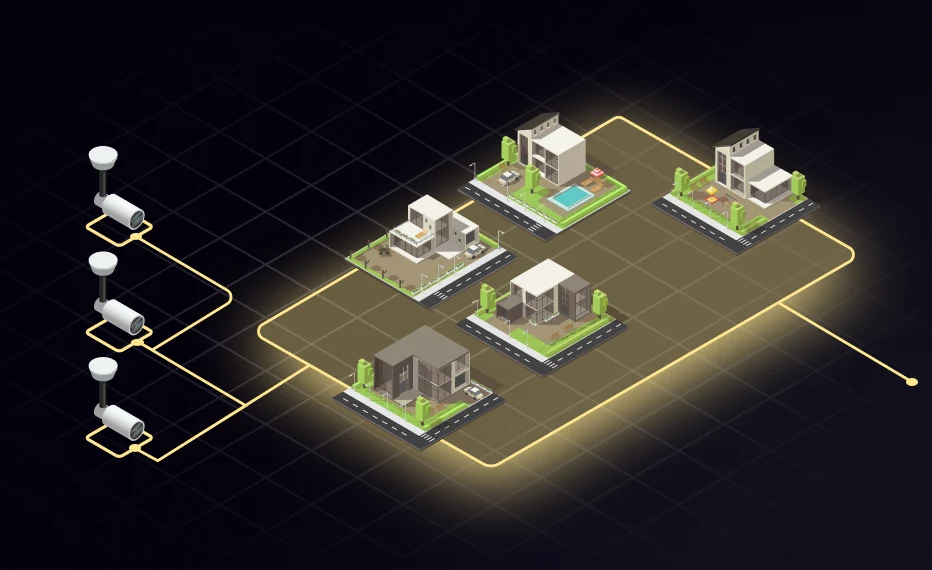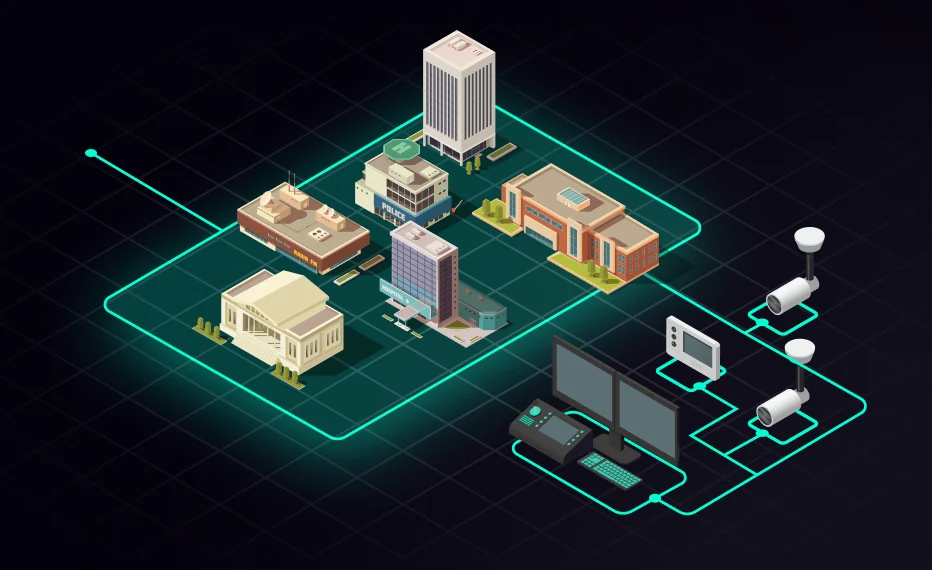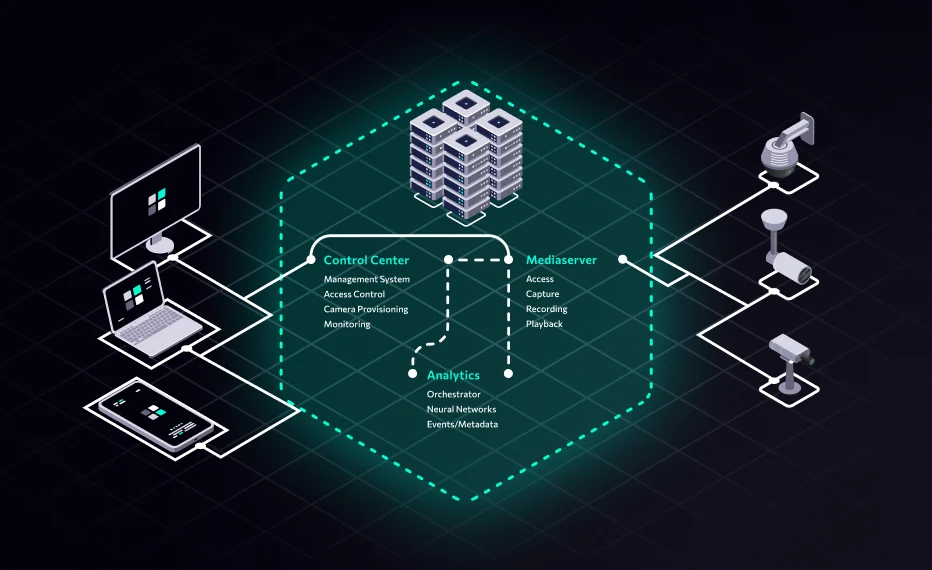What is Video Surveillance as a Service (VSaaS)?
Video surveillance technology has improved significantly from its origins. Traditionally, all surveillance occurred on-site, using wired cameras that people could only access and review from a central control area. Video Surveillance as a Service, or VSaaS, has emerged as a powerful alternative to traditional video surveillance systems. This cloud-based technology allows businesses to securely remote access and manage their security and surveillance systems from any location.
With cloud-based video surveillance solutions, organizations can benefit from all the functionality of a traditional video surveillance system without the traditional limitations. There is no longer a need for extensive on-premises equipment, such as video servers and disk drives, to record and store video footage. Businesses can also ditch routers and firewalls with insecure remote access methods like port forwarding or UPnP. Because VSaaS leverages the cloud, stakeholders can view live and recorded videos at any time from anywhere in the world using a mobile app or browser-based application.
VSaaS Essentials
A cloud-based video surveillance system will generally include the following components:
- VSaaS Subscription – Video surveillance as a service requires an ongoing subscription fee to maintain access to the video surveillance cloud system.
- Internet Protocol (IP) Cameras – IP cameras must be installed around the premises to maintain constant video surveillance. These cameras record video and send this information to the cloud.
- Internet connection – VSaaS requires stable internet connections to stream video. There is a great reliance on this connection with VSaaS when compared to traditional on-premise recording. But as internet bandwidths have increased and the use of H264/H.265/smart codec has become more popular in 2023, this is becoming less of an issue.
- Mobile app, browser-based application, or desktop clients – Access the App to view live and recorded videos stored in the cloud.

What is driving VSaaS growth?
The numerous benefits of Video Surveillance as a Service (VSaaS) drive its growth. It offers a cost-effective, scalable, and easy-to-manage solution that provides enhanced security and secure remote access. Here is a closer look at some of these benefits:
Better Oversight
Traditional video surveillance options have been a significant pain point for organizations looking to maintain proper oversight of business locations and facilities. Because conventional video surveillance systems are managed and stored onsite, recordings are unavailable for remote on-demand review. Setups with remote options may lean on firewalls with insecure access methods like port forwarding. This exposes the data to the internet, where any malicious actor can attempt to connect and access exposed devices.
Reduction in Resources
Another driving force in the growth of VSaaS is the reduction in IT resources and staff needed to manage video surveillance systems. With a traditional on-premise setup, businesses must invest in hardware, software, and infrastructure. These systems must then be maintained by IT staff. VSaaS eliminates much of this upfront investment.
Maintenance & Updates
Setup and maintenance are the two of the most commonly cited benefits of VSaaS. It typically offers plug-and-play connectivity for cameras/bridges and automatic software updates. Software updates are automatically managed by the VSaaS provider and typically do not require any user or integrator action. This greatly simplifies the system maintenance and upgrade process compared to most traditional VMS.
Additional capabilities
Advanced Features
Because VSaaS is on the cutting edge of cloud solutions, there are a number of advanced features that may not be available with traditional video surveillance software. Businesses can take advantage of facial recognition features, object tracking, and motion detection using emerging technologies like deep learning. With these features, organizations can better analyze their surveillance footage to identify any security concerns or other improprieties.
Analytics Included
Analytics are available with traditional VMS with extensive hardware resource spending and maintenance needed. Nevertheless organizations don’t need to invest significant resources into analytics when choosing VSaaS. Analytical solutions provided by VSaaS should deliver high accuracy, overcoming the constraints of local recorders or servers in terms of resources.
Extra Security
One of the key advantages of VSaaS is the extra security provided by the cloud. Most VSaaS providers use advanced encryption techniques to secure the data and footage stored. Virtually any business of any size stands to gain by switching to cloud storage for video surveillance. This includes small businesses and large enterprises in a wide range of industries like healthcare, hospitality, manufacturing, distribution, and even education. This prevents unauthorized access when malicious actors try to hack into surveillance systems and provides peace of mind to customers.
Video Surveillance as a Service Customers
VSaaS as a product offering has no limits to a narrow customer base. Virtually any business of any size stands to gain by switching to cloud storage for video surveillance. This includes small businesses and large enterprises in a wide range of industries like healthcare, hospitality, manufacturing, distribution, and even education.
Small Businesses
Small businesses can benefit from incorporating VSaaS as they may have limited resources to dedicate to constant surveillance staff and hardware. Using VSaaS, small businesses can protect their assets from theft while limiting the investment required to get a surveillance system up and running.
Business to Business (B2B)
VSaaS is especially useful for larger organizations with many facilities, assets, and employees to monitor. If VSaaS covers all distributed business areas, the business will have a video record of any everything that happens on their premises. It can offer great liability protection. Organizations can also help security protect all distributed assets. With a single video surveillance interface, everything is located in one place, offering more efficient oversight.
Business to Consumer (B2C)
VSaaS can also provide valuable surveillance to residential condominiums and private homeowners. This helps condominiums monitor the property’s perimeter and surveil common areas. Residents can subscribe to the video service to gain access to property cameras. In private homes, VSaaS can be integrated with IoT devices to allow for remote viewing of the property when the homeowner is away.
Government and Public Safety segment opportunities
Government and Public Safety Entities
Beyond business applications, VSaaS can benefit law enforcement, public safety organizations, and government agencies looking to keep communities safe with a robust monitoring system
Common VSaaS Use Cases
VSaaS has a variety of use cases, depending on the specific way an organization decides to leverage the technology. Here are some specific examples of ways different users and industries can utilize video surveillance as a service:
- Retail – Retail stores can use VSaaS to prevent shoplifting, monitor customers, and collect information on customer behavior. Stores can utilize remote surveillance to determine peak shopping hours and ensure staffing levels are optimized.
- Education – Many institutions use video surveillance to monitor campus activity, prevent bullying and violence, and foster student safety. This is especially important given the current concerns about the safety of schools.
- Healthcare – Facilities can use VSaaS to monitor secure areas, such as the hospital pharmacy and areas where patient records are stored, to protect drug inventory and patient privacy (HIPAA).
- Manufacturing – Safety and production are major concerns for companies operating in the manufacturing space. With 24/7 cloud-based video surveillance, management can monitor production lines and ensure compliance with safety regulations, thus preventing worker injury or death.
- Hospitality – Hotels and resorts can keep a close eye on their facilities to ensure the safety of guests and to prevent unwanted loitering or unauthorized individuals on their property.
Additional industries
Telecom Service Providers – TSPs can use this technology to offer cloud-based surveillance services as a subscription option for their existing and potential customers, thereby adding additional revenue stream. This can be particularly appealing to organizations that want to outsource their video surveillance needs. As it’s more convenient to use their existing telecom service provider than to engage in a business relationship with another company.

Rise of Video Surveillance as a Service
VSaaS has grown in step with other cloud-based sectors, such as Software as a Service (SaaS), Infrastructure as a Service (IaaS), and Platform as a Service (PaaS). 93% of businesses have already adopted at least one cloud solution. The cloud has unlocked so many new capabilities within the IT sector.
Video surveillance systems are a given within certain industries, such as banking, government, manufacturing, distribution, and healthcare. Companies within these industries were some of the first to transition to VSaaS.
But video surveillance as a service is quickly expanding to new industries. As more and more organizations realize the immense value of overseeing and monitoring their assets and facilities. From a business perspective, there is no downside to VSaaS when considering the remote-viewing capabilities, long-term cloud storage, and reduction in IT resources and costs.
Improvements in video compression and the increasing accessibility of high-speed internet have also contributed to the growth of video surveillance as a service.

Hosted, Managed, and Hybrid
Different organizations have different needs when it comes to the level of customization and control required of their video surveillance system. Two primary VSaaS options have emerged to address these different needs and preferences:
Businesses looking for an out-of-the-box option can turn to a hosted VSaaS provider. The provider will host the video surveillance system on their cloud servers, allowing the company to access the system through a web-based portal or mobile app.
While businesses that need greater flexibility and control over their security and surveillance system can utilize a managed VSaaS system. The communication service provider will host the surveillance system on their servers and help the company manage the system. This usually includes system configuration, software updates, troubleshooting, and security monitoring. The organization can dictate specific requirements and work with the service provider to ensure all surveillance capabilities are set up and working as intended.
Hybrid
Hybrid VSaaS setups share some of the advantages of a hosted setup, like secure remote monitoring and cloud management. But hybrid also offers temporary on-site storage that can hold recordings in the case of an internet outage for upload once the connection has been reestablished with the cloud. Hybrid VSaaS also generally supports open third-party cameras.
Emerging Cloud Computing Trends
The VSAAS market is thriving and statistics projects to grow at a CAGR of 18.3% over the next 7 years as more and more organizations shift away from on-premise security solutions. Cloud computing is rapidly transforming the security industry by offering new cloud-based security services that weren’t possible 10 years ago.
Within the next few years, machine learning and artificial intelligence advancements will open even more doors within the video surveillance market. This will help businesses respond to security threats in real-time by alerting them of potential security concerns. For instance, object detection algorithms may identify and warn companies when possible weapons or tools are seen on their cameras, which may pose a risk to people or property.
Another exciting cloud computing trend is edge computing. Edge computing will help organizations which are concerned about their data being hosted off-site. This technology moves computing devices to the edge of the network, in close proximity to IoT devices, sensors, and cameras. When data is processed at the edge of the network, latency and performance of real-time applications are improved.

Aipix Platform
As edge computing is gaining traction by addressing the concerns of organizations hesitant about off-site data hosting by positioning computing devices near IoT devices, sensors, and cameras, it is paving the way for innovative platforms like Aipix Telecom VSaaS.
With the Aipix platform, Telecom service providers can launch their own cloud-based video surveillance services and AI security services to drive new revenue streams. This includes B2B, B2C, and B2G business cases, such as construction, banking, retail, transportation, and much more. Aipix offers AI-based video analytics, white-label solutions for personal branding, a full range of user interfaces, and API-based integration. We provide a ready-made solution, so Telecom providers can quickly launch their own cloud video surveillance service.
Ready to take your business to the next level?
Let’s discuss how Aipix can help.





